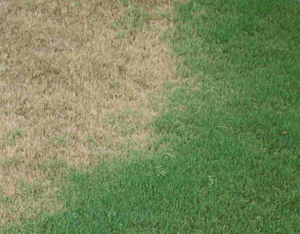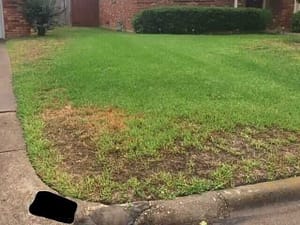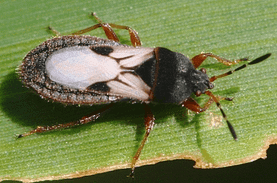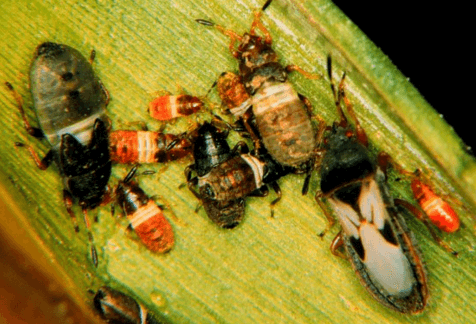Identifying Chinch Bug Infestations and Control
Chinch bugs, the notorious lawn pests, can wreak havoc on your turf if not identified and managed promptly. These tiny insects are particularly fond of warm weather and can cause extensive damage to grass by sucking out sap from the blades. As summer approaches and you are controlling chinch bugs it’s vital to be vigilant since heavy infestations can lead to large areas of dead or dying grass—an unsightly sight for any homeowner or professional lawn care technician.
Recognizing the signs of a chinch bug infestations is crucial for effective management. Look for:
- Irregular patches of brown grass that resemble drought stress.
- Small, straw-colored insects located near the base of grass blades.
- Adult chinch bugs measuring about 1/8 inch long with a distinctive black and white pattern.
The first step in chinch bug control is understanding their life cycle. Chinch bugs undergo several stages:
- Eggs: Laid in clusters on grass blades, they hatch in just 7-10 days.
- Nymphs: The young bugs are smaller and often red to orange in color.
- Adults: Mature chinch bugs transition into their characteristic black and white form.
Deter Them Before They Invade
Preventing chinch bugs is always better than controlling chinch bugs as an existing problem. Here are some effective strategies:
- Aerate your lawn to improve drainage and reduce thatch build-up where chinch bugs thrive.
- Mow your grass at a height of at least 3 inches; this helps create a healthier turf that's more resistant to pest damage.
- Implement proper irrigation practices; over-watering can lead to conditions favorable for chinch bug survival. Underwatering can cause the grass to go into stress and also make it more vulnerable.
- Resistant turf grass. Perennial ryegrass, fine fescues and tall fescues are highly resistant to chinch bugs. Empire Zoysia has rhizomes that branch off under the soil’s surface, so chinch bugs are not able to access it. Even if the chinch bugs damage your lawn above the soil’s surface, the grass will continue to survive and grow. In lawns with both Bermuda and St. Augustine, the chinch bugs tend to attack the St. Augustine while leaving the Bermuda alone.
If you do spot these pests lurking in your lawn, don’t panic! Learning how to get rid of chinch bugs effectively will save your turf. Here are some treatment options:
- Chemical control: Certain insecticides are specifically formulated for controlling chinch bugs. Always review application instructions carefully. The chemicals you will need to look for are trichlorfon, bifenthrin, imidacloprid, and carbaryl.
- Natural remedies: Diatomaceous earth and neem oil have shown effectiveness against chinch bugs without harming beneficial organisms. Earwigs will eat 50 chinch bugs a day but we can’t dump earwigs on a lawn.
"An ounce of prevention is worth a pound of cure." - Benjamin Franklin
This age-old advice rings especially true when it comes to managing these pesky pests. Regular monitoring during peak seasons ensures you catch infestations early before they escalate into more considerable issues. With the right knowledge and tools, keeping your lawn healthy and vibrant amidst potential threats from chinch bugs is entirely achievable!

Understanding Chinch Bugs
Understanding chinch bugs is essential for anyone involved in lawn care, from DIY enthusiasts to professional technicians. These pests thrive in warm weather and can cause significant damage if left unchecked. Let's delve deeper into the biology and behavior of these notorious lawn marauders.
The Chinch Bug Life Cycle
Chinch bugs go through several life stages, each offering distinct opportunities for management:
- Eggs: Typically laid in clusters on grass blades, they are small and hard to spot. Each female chinch bug can lay up to 300 eggs, leading to rapid population growth.
- Nymphs: After hatching in about 7-10 days, the immature bugs are initially red, transitioning to yellow or pale green as they grow. At this stage, they are voracious feeders and more vulnerable to treatment.
- Adults: Mature bugs are about 1/8 inch long with a striking black and white pattern. They are often found near the base of grass blades, making them easier to identify during inspections.


Signs of Chinch Bug Damage
The symptoms of chinch bug damage can be mistaken for drought stress or other lawn issues. However, knowing how to identify them accurately will save you time and effort:
- Browning patches: Look for irregular patches of brown grass that do not improve with watering. This is a telltale sign of chinch bug activity.
- Lawn discoloration: The grass may appear wilted and have a scorched look around the edges—often a result of prolonged feeding.
- Presence of adults: Regularly check for the small straw-colored insects near grass bases; their presence indicates potential issues before severe damage occurs.
Monitoring
There are several ways to check for chinch bugs. First, get down on the ground and look in the area between green grass and brown grass.
Another way is to use a blower in reverse and suck up anything loose in an area. You can open the bag and look for chinch bugs inside.
Another way is to take an empty coffee canister or any that can closely resemble this and make sure it is open on both sides so that it does not have a top or a bottom. You should be able to remove the top and the bottom of the can with a can opener the same way you would open a can of beans in the kitchen.
Once you have removed the top and the bottom, stick the can three inches deep into the soil. You may have to force the end of the can into your lawn or dig a small hole prior to setting the can up.
Fill up 3/4s of the can with water and let it sit for ten minutes. After the ten minutes are up, stir the water so that you agitate everything inside and see if any chinch bugs float to the top.
After you have seen chinch bug damage several times you will know it when you see it and it won’t be hard to find the insects. I have walked on lawns many times and seen them crawling on my shoes. If you see a few, there are probably hundreds if not thousands.
Optimal Timing for Monitoring
The best time to watch out for chinch bugs is during late spring through summer when temperatures rise. Remember these key points:
- Peak activity generally occurs from late May through August due to increased warmth.
- Avoid over-fertilizing or over-watering during peak season; both can make your lawn susceptible to infestations.
If you’re seeking effective ways to mitigate infestations, knowledge about chinch bug life stages enables you to target treatments at the right time effectively. Early detection leads to better outcomes!
This comprehensive understanding equips professionals and homeowners alike with the tools necessary for effective lawn pest control. In your quest against these minuscule invaders, remember that vigilance is key!
Identifying Chinch Bugs
Identifying lawn chinch bugs can be an essential skill for any lawn care professional or DIY enthusiast. These tiny pests, measuring about 1/8 inch, are known for their distinctive black and white markings, making them somewhat easier to spot against the vibrant green of your grass. However, their small size and the camouflage of grass blades mean they often go unnoticed until significant damage has been done.
Visual Identification
To effectively identify chinch bugs in your lawn, keep an eye out for the following characteristics:
- Color and Size: Adult chinch bugs exhibit a striking black and white coloration. Their small size can make them hard to detect, so a magnifying glass might come in handy!
- Nymphs: These young bugs are typically red or orange during their early stages. Spotting these before they mature into adults gives you an edge in pest management.
- Location: You’ll generally find chinch bugs residing near the base of grass blades, especially where grass is under stress.

Symptoms of Chinch Bug Damage
The symptoms of chinch bug damage can mimic drought stress or other environmental issues, which is why proper identification is crucial. Look for:
- Irrigation Issues: If brown patches appear even after watering efforts fail to rejuvenate them, be suspicious—it's a classic sign of a chinch bug infestation.
- Patches of Death: Irregular patches of dead or dying grass can be indicative of chinch bug activity; these patches often expand over time without intervention.
- Sooty Mold: Heavy infestations may result in sooty mold forming on grass due to honeydew secretions from the bugs themselves—a clear indicator that something’s amiss!
The Importance of Timing
Catching a chinch bug infestation early requires regular monitoring, particularly during the warmer months. Here are some timing tips to keep in mind:
- Peak Season: Monitor your lawn closely from late spring through summer when temperatures rise above 80°F.
- Diligent Inspections: Conduct inspections weekly during peak season to quickly identify any signs of trouble before they escalate into heavy infestations.
The Impact of Temperature
The chinch bug life cycle is heavily influenced by temperature:
- Warm weather accelerates development; hence they thrive in temperatures above 80°F.
- A single generation can develop within just three weeks during peak conditions, leading to rapid population increases if left unchecked.
Identifying Key Times for Intervention
Monitoring your lawn during critical periods can significantly improve your chances of catching infestations early:
- Summer Watchfulness: Late spring through summer is when adults are most active and likely to cause damage. Regular inspections during these months are vital.
- Drought Stress vs. Chinch Bug Damage: Symptoms such as irregular brown patches can resemble drought stress; however, without improvement despite adequate watering, consider a chinch bug infestation as a potential cause.
"Knowledge is power." - Francis Bacon
This age-old wisdom holds especially true in pest management. By understanding the life cycle of chinch bugs, you gain valuable insights into their behavior and vulnerabilities throughout their developmental stages. As you navigate your lawn care routine—whether through chemical control or natural remedies—you'll be better equipped to implement timely interventions that keep your turf healthy and resilient against these persistent pests!
Signs of Chinch Bug Infestation
When it comes to spotting a chinch bug infestation, knowledge is your best ally. These pests are sneaky little critters, and their presence can often be mistaken for other lawn issues. Knowing the tell-tale signs of these sap-sucking nuisances is crucial for anyone involved in lawn care, whether you're a homeowner or a professional technician.
Visible Indicators of Infestation
As you inspect your lawn, look out for the following signs:
- Browning Patches: One of the most obvious symptoms is irregular patches of brown grass that resemble drought stress. However, unlike drought-stressed areas, chinch bug-infested patches often do not return to green after watering.
- Pale Grass Blades: Chinch bugs feed on the sap in grass blades, leading to wilting and discoloration. The edges may turn yellow or brown, giving it a scorched appearance.
- Presence of Adults: Adult chinch bugs are approximately 1/8 inch long with distinctive black and white markings. Look near the base of grass blades—this is where they tend to congregate.
The Sooty Mold Connection
If you notice dark mold-like spots on your grass, this could also indicate a heavy chinch bug population. This sooty mold forms due to honeydew secretions from these insects, creating an unsightly and unhealthy environment for your turf.
The Timing Game
Chinch bugs thrive in warm weather; therefore, being proactive during peak seasons can save your lawn from significant damage. Here are some key points for optimal monitoring:
- Spring Through Summer: Keep an eye out from late May through August when temperatures rise above 80°F—this is when chinch bugs are most active.
- Frequent Inspections: Conduct thorough inspections weekly during peak seasons to catch early signs and prevent major infestations.
"A pest you catch early is a pest half defeated!"
This playful adage rings true in the case of chinch bugs. Early detection not only allows for quicker intervention but also increases the likelihood of successful control measures. With vigilant monitoring and awareness of the signs of chinch bug damage, you'll be better equipped to take action before they wreak havoc on your prized lawn!
Preventing Chinch Bug Damage
Preventing chinch bug damage is an essential task for maintaining a healthy lawn. With their reputation for causing extensive turf destruction, a proactive approach can save you time, effort, and money down the line. Here are some effective strategies to keep these pesky pests at bay:
1. Maintain Healthy Turf
A robust lawn is your first line of defense against chinch bugs. Consider the following:
- Mow High: Keeping your grass at a height of at least 3 inches promotes deeper root growth and increases resilience to pests.
- Choose Resistant Grass Varieties: Some grass types, like tall fescue and zoysia, are more resistant to chinch bug infestations compared to others. Opting for these varieties can enhance your lawn's defenses.
2. Proper Irrigation Practices
Irrigation plays a significant role in pest management:
- Water Deeply but Infrequently: This encourages deeper root systems and lessens stress on your grass. Aim for about 1 inch of water per week.
- Avoid Overwatering: Excess moisture creates an environment conducive to chinch bug survival. Ensure drainage is adequate to prevent pooling.
3. Soil Health Management
The health of your soil directly impacts how well your lawn can fend off pests:
- Aeration: Aerating your lawn reduces thatch buildup and improves soil aeration, which can deter chinch bugs from making themselves at home.
- Nourish Your Soil: Regularly testing soil health allows you to adjust nutrient levels appropriately; healthy soil supports robust grass growth that deters pests.
4. Monitor Regularly
Your eyes are one of the best tools in preventing infestations:
- Seasonal Checks: Keep a close watch during late spring through summer when chinch bugs are most active. Regular inspections help catch early signs before they escalate.
- Sweep Tests: Conduct simple tests by sweeping a white cloth over the grass; if you see small black-and-white insects falling onto it, chinch bugs may be present.
"An ounce of prevention is worth a pound of cure." - Benjamin Franklin
This timeless wisdom applies aptly here! By fostering strong lawns through proper care techniques, you make significant strides in preventing chinch bug damage before it begins. Stay informed about their life cycle and behavior patterns, so you can act swiftly should the need arise—all while enjoying your beautiful green space!
Treatment Options for Chinch Bugs
When it comes to dealing with a chinch bug infestation, the treatment options can vary depending on the severity of the problem and your personal preference for management methods. Whether you’re a professional lawn care technician or a dedicated DIY enthusiast, understanding your options is crucial for effective chinch bug control.
Chemical Control
If you find yourself facing a heavy infestation, chemical solutions might be necessary. Here are some key points to consider:
- Insecticides: Look for products specifically labeled for chinch bugs. Pyrethroids, such as bifenthrin and permethrin, are commonly used and can provide quick relief from these pests.
- Timing Matters: Apply insecticides when chinch bugs are most active—typically late spring through summer. This ensures you target them at their peak feeding time.
- Follow Instructions: Always read the label carefully before application to ensure safety and effectiveness. Proper timing and method of application can significantly influence results.
Naturally Derived Solutions
If you're leaning toward greener options, several natural remedies have shown promise in combating chinch bugs:
- Diatomaceous Earth: This fine powder made from fossilized algae acts as a desiccant, damaging the exoskeletons of chinch bugs on contact. Sprinkle it around affected areas for best results.
- Neem Oil: Derived from the seeds of the neem tree, this oil disrupts the life cycle of insects when ingested or absorbed through their exoskeletons. It’s effective against both nymphs and adults.
Cultural Practices
Incorporating certain cultural practices into your lawn care routine can also support chinch bug treatment efforts:
- Aeration: Aerating your lawn reduces thatch build-up, creating less favorable conditions for chinch bugs while promoting healthy grass growth.
- Mowing Properly: Maintaining grass at an optimal height (around 3 inches) allows for better resilience against pest damage while making it harder for chinch bugs to thrive.
The Importance of Ongoing Monitoring
No matter what treatment option you choose, ongoing vigilance is essential. Regular monitoring during peak seasons helps you identify any resurgence before it spirals out of control. Here are some tips:
- Sweep Test: Regularly conduct sweep tests to check for adult chinch bugs by sweeping a white cloth across your lawn to spot any unwanted visitors.
- Patching Up: If brown patches continue to spread post-treatment, consider reapplying appropriate methods or consulting with a lawn care professional for further assistance.
"The best approach is always one that combines knowledge with action." - Unknown Author
This philosophical insight rings especially true in managing chinch bugs! Understanding their life stages—along with specific treatment options—will empower you to take decisive action swiftly. With diligence and proper care techniques, achieving a healthy, thriving lawn amidst the threat of these persistent pests becomes an attainable goal!
Best Practices for Lawn Care to Prevent Chinch Bugs
To effectively prevent chinch bugs from turning your lush lawn into a parched desert, adopting best practices in lawn care is non-negotiable. These proactive measures can safeguard your turf against the notorious lawn chinch bug, ensuring that your green space remains vibrant and healthy.
1. Maintain Optimal Lawn Health
A healthy lawn is your first line of defense against pests:
- Mow Regularly: Keep grass at a height of 3 to 4 inches. This not only encourages deep root growth but also creates a more resilient turf that can withstand chinch bug attacks.
- Choose Resistant Grass Varieties: Species like zoysia and tall fescue have demonstrated greater resistance to chinch bug damage compared to others. Planting these types can bolster your defenses against infestations.
2. Proper Watering Practices
Irrigation methods play a crucial role in preventing chinch bugs:
- Water Deeply, But Less Frequently: Instead of shallow daily watering, provide about 1 inch of water once or twice a week. This promotes strong root systems and reduces stress on the grass.
- Avoid Overwatering: Excess moisture creates an environment conducive to pest survival. Ensure proper drainage to minimize pooling, which can attract chinch bugs.
3. Soil Health Management
The condition of your soil directly impacts how well your lawn can fend off pests:
- Aeration is Key: Aerating the lawn helps break up compacted soil and reduces thatch, making it harder for chinch bugs to find a suitable environment.
- Nutrient Balance: Regular soil tests allow you to adjust nutrient levels appropriately; healthy soil leads to stronger grass which deters pests.
"An ounce of prevention is worth a pound of cure." - Benjamin Franklin
This age-old wisdom rings especially true in the battle against chinch bugs! By maintaining healthy lawns through proper care techniques and vigilant monitoring, you're not just defending against potential invaders—you're cultivating an environment where they simply can't thrive. With these best practices in place, you'll be well on your way to keeping those pesky chinch bugs at bay!
Turf Pests Management Strategies
When it comes to managing turf pests like the lawn chinch bug, a comprehensive strategy is essential for both prevention and control. These small but mighty insects can quickly turn a vibrant lawn into a patchy wasteland if left unchecked. Fortunately, there are several effective management strategies tailored for lawn care professionals and DIY enthusiasts alike.
1. Integrated Pest Management (IPM)
The cornerstone of effective chinch bug control lies in adopting an Integrated Pest Management (IPM) approach, which combines multiple strategies for optimal results:
- Monitoring: Regularly inspect your lawn for signs of chinch bugs, especially during peak seasons. This proactive step allows you to catch infestations early.
- Cultural Practices: Implement healthy turf practices such as proper mowing heights, irrigation techniques, and soil health management to create an environment less favorable to chinch bugs.
- Biological Controls: Consider encouraging natural predators of chinch bugs, such as certain types of birds or beneficial insects that feed on them.
2. Timing Is Everything
Understanding the behavioral patterns of chinch bugs can guide your management efforts effectively:
- Seasonal Awareness: Monitor lawns closely from late spring through summer when temperatures soar above 80°F—this is when chinch bugs are most active.
- Treatment Timing: Apply treatments—whether chemical or natural remedies—when the pests are in their nymph or adult stages for maximum efficacy.
3. Soil Health and Lawn Maintenance
The condition of your lawn directly impacts its resilience against pests:
- Aeration: Regularly aerating your lawn helps alleviate compaction and improves drainage, making it harder for chinch bugs to thrive.
- Nutrient Management: Ensure that your soil is well-nourished through regular testing and amendments; healthy grass roots can better resist pest damage.
4. Chemical Control Options
If you find yourself facing a heavy infestation, chemical options may be necessary. Here’s what you should know:
- Selecting Insecticides: Choose products specifically formulated for chinch bug treatment, such as pyrethroids or neonicotinoids; always follow label instructions for safety and effectiveness.
- Application Timing: The best time to apply insecticides is early in the morning or late in the evening when beneficial insects are less active, and the product can adhere better to target areas.
Conclusion: Managing Your Lawn Effectively Against Chinch Bugs
In conclusion, managing your lawn effectively against the notorious lawn chinch bug requires a multifaceted approach that incorporates prevention, identification, and timely treatment. The key to keeping these pests at bay lies in understanding their lifecycle and recognizing the signs of a chinch bug infestation early on.
Implementing Preventative Measures
A proactive strategy is vital for avoiding chinch bug damage. Here are essential best practices:
- Healthy Turf Management: Maintain a robust lawn by mowing at the right height, choosing resistant grass varieties, and ensuring proper irrigation practices.
- Soil Health Monitoring: Regular soil testing and aeration help promote healthy roots and reduce thatch buildup—making your lawn less appealing to pests.
- Regular Inspections: Keep an eye on your lawn during peak seasons, particularly from late spring through summer, for potential signs of chinch bugs.
Treatment Options Recap
If you do encounter chinch bugs despite your best efforts, don't despair! Remain calm and consider these treatment options:
- Chemical Solutions: Use insecticides specifically formulated for chinch bugs during their active phases for maximum effectiveness. Start with preventative insecticide treatments about every 60 days through the growing season. The lawn shouldn’t need a curative if pre-treated. Using fertilizer with embedded insecticide is the easiest and most efficient way to pre-treat the lawns. The chemicals you will need to look for are trichlorfon, bifenthrin, and carbaryl
- Naturally Derived Remedies: Options like neem oil or diatomaceous earth can be effective without harming beneficial insects.
This insightful quote resonates well within the context of lawn care. By actively managing your turf and anticipating challenges from pests like chinch bugs, you can ensure a healthy, lush environment that stands strong against potential threats. Remember that vigilance combined with informed action is your best defense—so gear up with knowledge, embrace effective practices, and keep those pesky chinch bugs where they belong: far away from your beautiful lawn!


